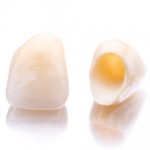Aesthetic is a very important consideration for anterior teeth so tooth coloured crowns are only applicable here and can be divided into different types :
All ceramic crown
Examples of all ceramic crowns
Traditional porcelain jacket crown (PJCs) is the oldest type of tooth coloured crown and it consists of 1 – 2 mm thick of porcelain. PJC is relatively brittle but after it is cemented it requires same amount of force to fracture our tooth enamel. To overcome the brittleness of PJCs, many types of stronger crowns have been developed.
Zirconia cores is another type of all ceramic crowns. Zirconia is a very strong material but it is dense white and required thick layers of porcelain underneath to mask the opacity of zirconia.
So what are the advantages of ceramic crowns?
Ceramic crowns are available in various shades and your dentist surely will pick the best shade to represent your natural tooth color thus esthetically wise,  ceramic crown will be a better choice.Ceramic crowns are also less costly compared to metal- ceramic crowns. They are dimensionally and color stable. Although ceramic crowns such as Porcelain jacket crown are more brittle but when it fractures , it doesn’t involve the root of the tooth.
So should we just choose ceramic crowns instead or metal ceramic crowns?
Wait, there are some disadvantages that you should know about ceramic crowns.
Older types of ceramic crowns have less satisfactory marginal fit compared to metal ceramic crowns. As we have mentioned earlier,ceramic crowns are brittle and it cannot be used in patients where there is excessive occlusal forces such as bruxism patients. Removal of tooth structure is also needed to overcome brittleness of porcelain and to resemble the natural appearance of tooth thus it is more likely to weaken the tooth and involve the pulp.
Metal ceramic crowns
Metal ceramic crowns are strong and requires minimal reduction on the palatal side which is the back of our tooth and it is advisable to be given on teeth which are eroded, other than that the crown can be adapted to any shape of tooth preparation where as for all ceramic crowns, a smooth tooth preparation is required.
Metal ceramic crowns are strong but when it fractures, it might cause damage to the toot because it is stronger than our dental tissues.Other than that, metal ceramic crowns  might not resemble our natural tooth color compared to all ceramic crowns. Metal ceramic crowns is also most costly and the laboratory time to construct is longer.
Other types of anterior crowns are:
Cast metal crowns with acrylic and composite facing.
Fiber reinforced composite crowns.
For posterior teeth,
Cast metal crowns can be given if the patient doesn’t mind the appearance of the metal. Cast metal crowns required less reduction of tooth structure and it is best used in areas where occlusal stress is high. In older times, gold crowns are given but is replaced by other types of alloy due to high cost.
Ceramic crowns can be given on posterior teeth but it is not advisable to used on patients who have bruxism. Metal ceramic crowns are esthetically pleasant on posterior teeth but certain amount of tooth preparation is required to accommodate porcelain.
Three quarter crown is another type of crown where the crown covers mesial, distal, occlusal, lingual, palatal of your tooth .It is more conservative as the buccal surface of tooth is remained intact.
It is best to discuss with your dentist to find out what types of crown is best for you before any tooth preparation procedure takes place.

Thanks for this helpful article!
These crowns can help restore our beautiful smile.. not to mention the beauty of our teeth. Nice post indeed.
Thanks
PJ
Author <a href="http://http://www.dentistminnetonka.com/"Dentist Minnetonka"